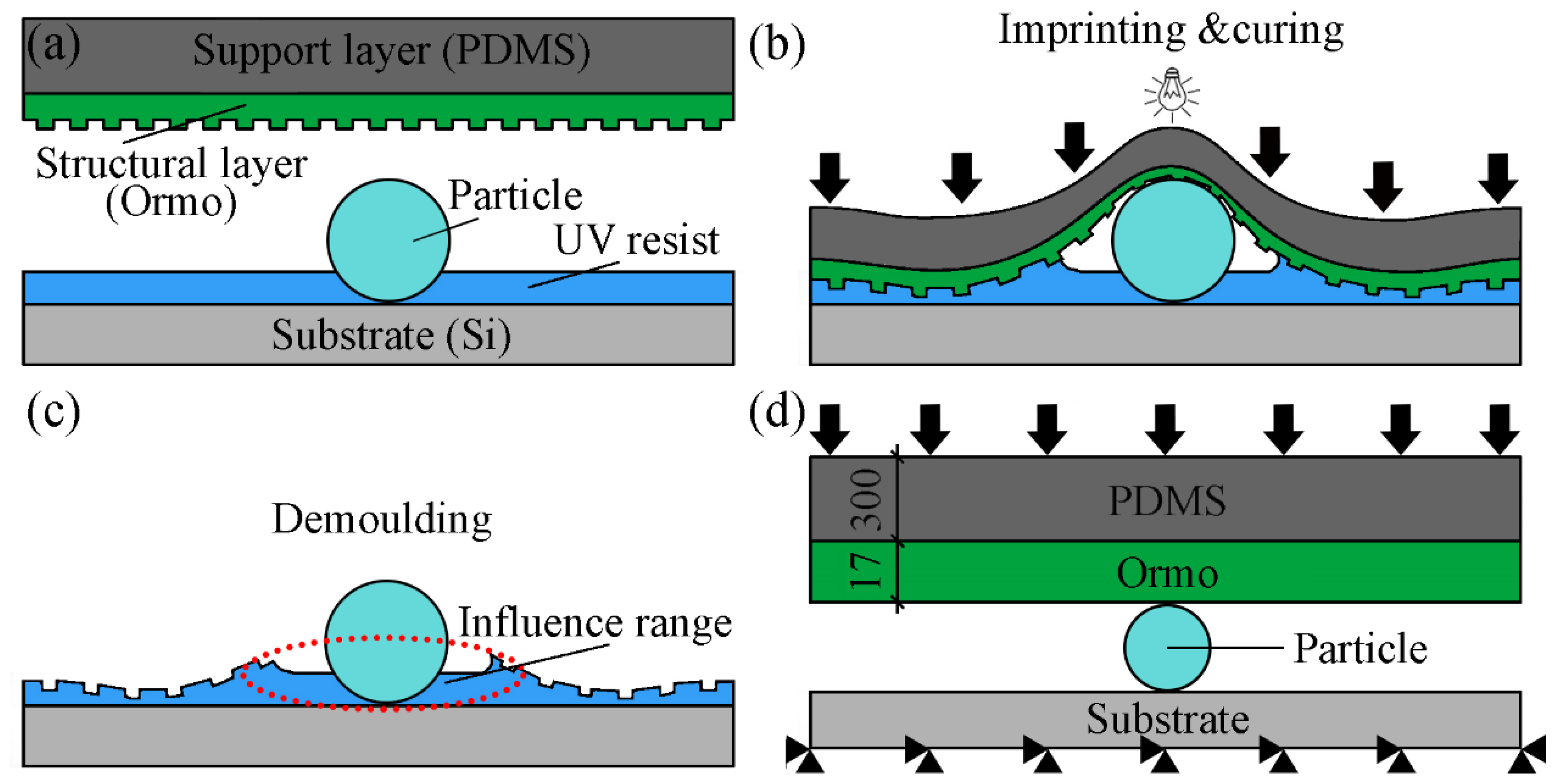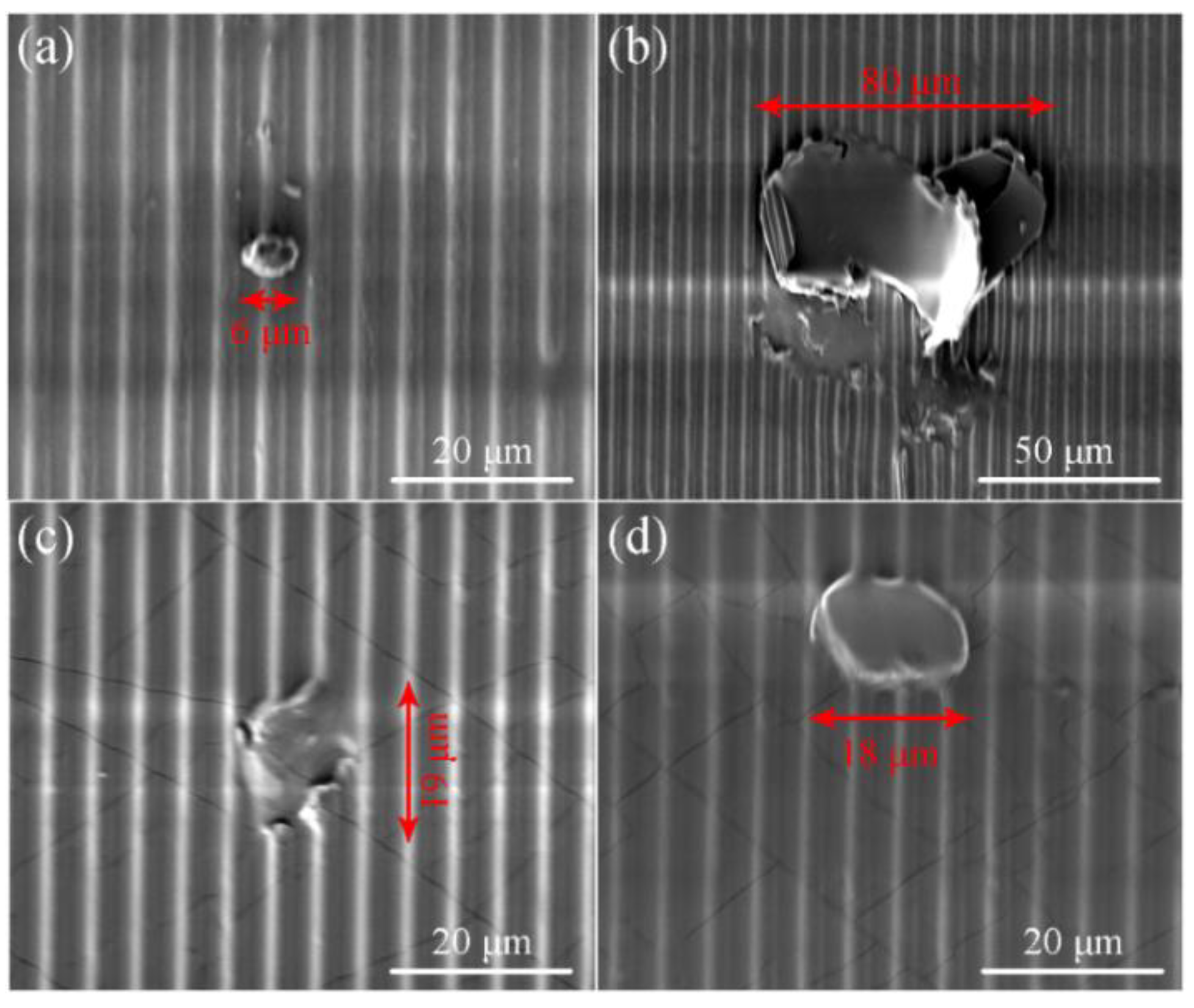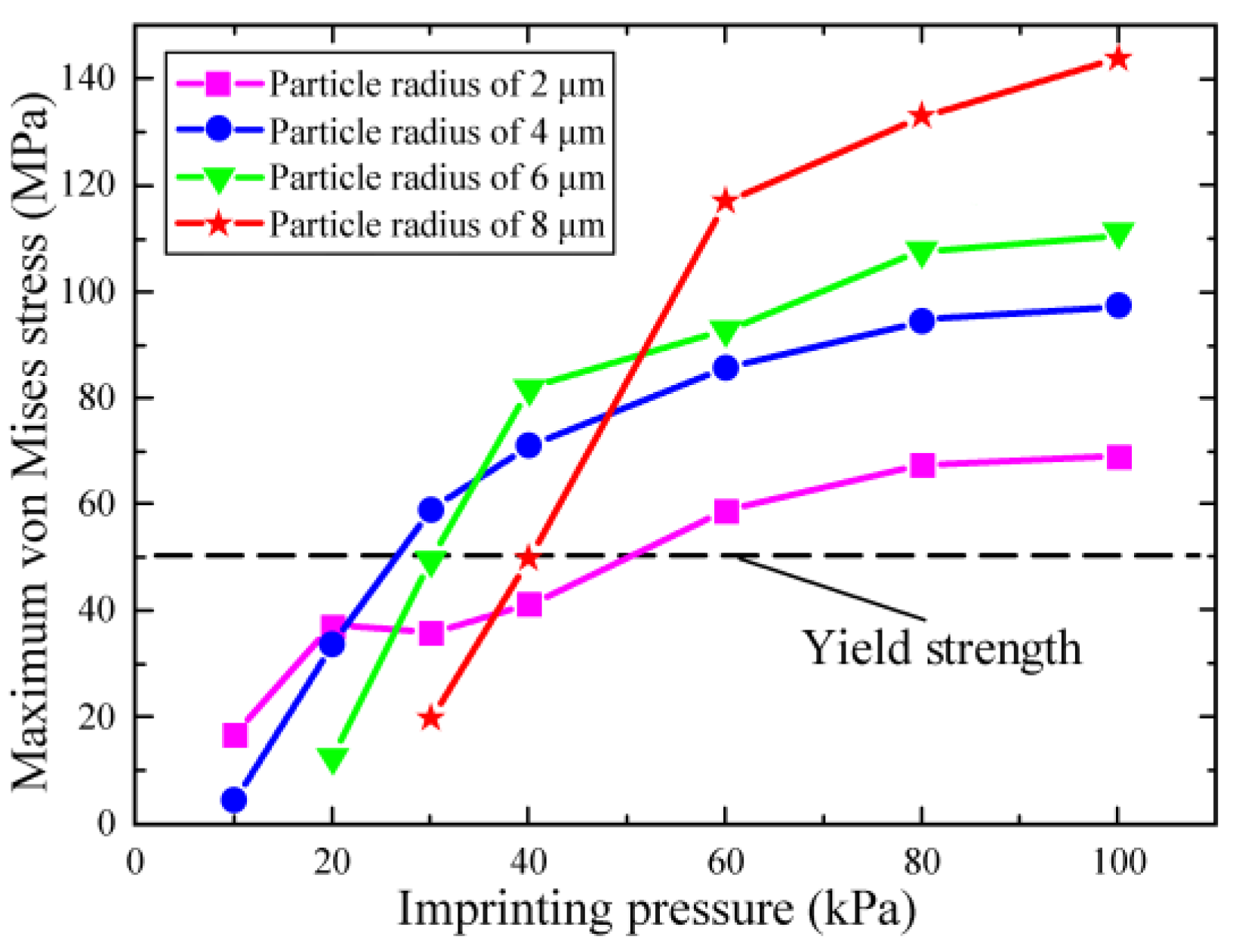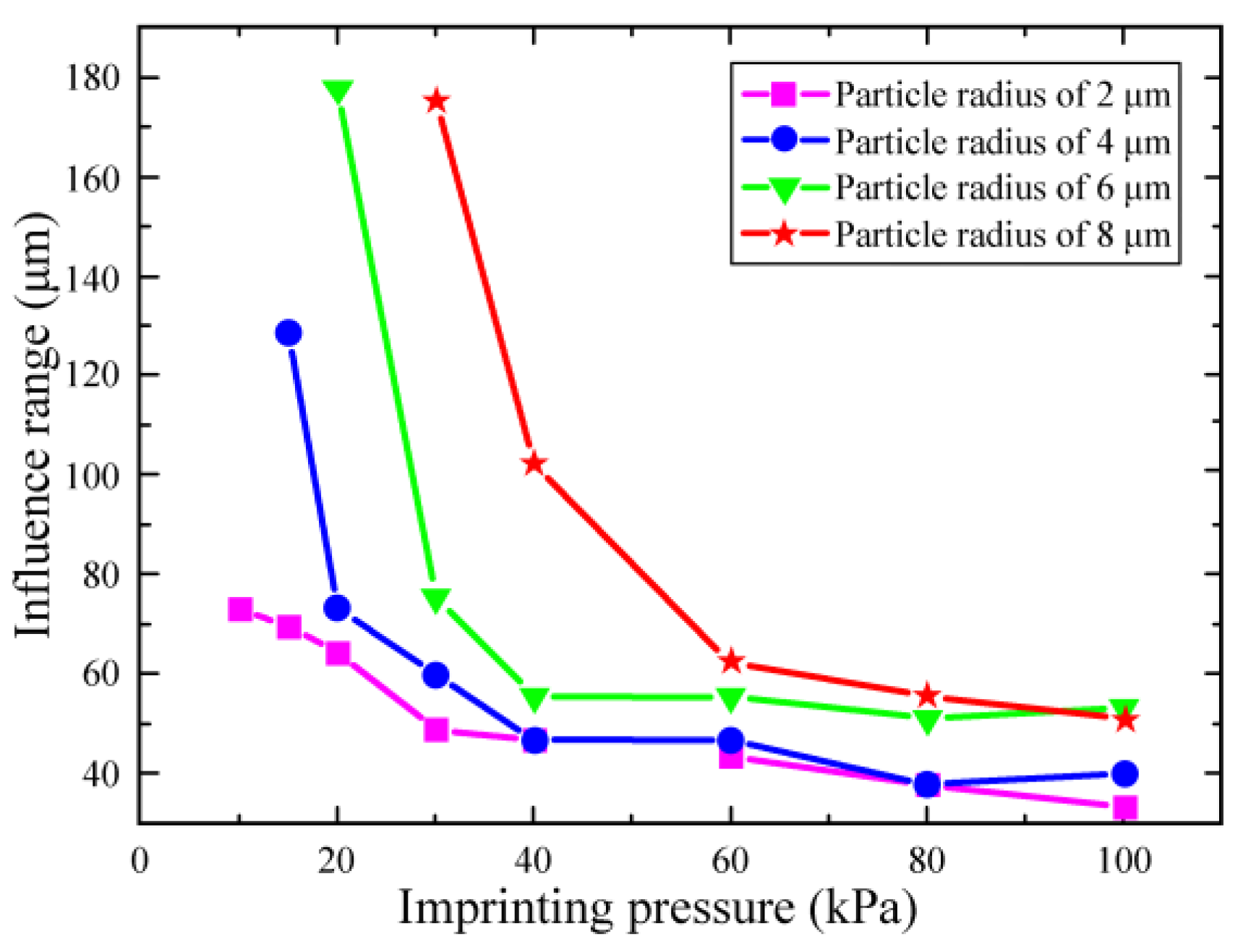Effects of Imprinting Pressure on the Damage of Flexible Composite Mould and Pattern Quality during UV Nanoimprinting
Abstract
:1. Introduction
2. Methods and Modeling
2.1. Experiment
2.2. Numerical Simulation
3. Results and Discussions
3.1. Morphology of the Fabricated Grating Pattern
3.2. Von Mises Stress Distribution and Defects
3.3. Effects of Imprinting Pressure on Composite Mould
3.4. Effects of Imprinting Pressure on Pattern Quality
4. Conclusions
Author Contributions
Funding
Conflicts of Interest
References
- Yu, C.C.; Chen, H.L. Nanoimprint technology for patterning functional materials and its applications. Microelectron. Eng. 2015, 132, 98–119. [Google Scholar] [CrossRef]
- Lan, H.; Liu, H. UV-nanoimprint lithography: Structure, materials and fabrication of flexible molds. J. Nanosci. Nanotechnol. 2013, 13, 3145–3172. [Google Scholar] [CrossRef] [PubMed]
- Mekaru, H. Formation of metal nanostructures by high-temperature imprinting. Microsyst. Technol. 2014, 20, 1103–1109. [Google Scholar] [CrossRef]
- Zheng, X.; Wang, Q.; Zhang, R.; Ma, L.; Luan, J. Effects of aspect ratio and metal layer thickness on demoulding of metal/polymer bilayer gratings during nanoimprinting. Sci. Rep. 2018, 8, 12720. [Google Scholar] [CrossRef]
- Kim, K.S.; Kim, J.H.; Lee, H.J.; Lee, S.R. Tribology issues in nanoimprint lithography. J. Mech. Sci. Technol. 2010, 24, 5–12. [Google Scholar] [CrossRef]
- Wang, Q.; Zheng, X.; Zhang, R.; Zhang, J.; Ma, L.; Liu, H. Analysis of the metal/polymer bi-layer structure during demolding process of nanoimprinting. J. Photopolym. Sci. Technol. 2015, 28, 763–767. [Google Scholar] [CrossRef]
- Bhingardive, V.; Menahem, L.; Schvartzman, M. Soft thermal nanoimprint lithography using a nanocomposite mold. Nano Res. 2018, 11, 2705–2714. [Google Scholar] [CrossRef]
- Maurer, J.H.M.; González-García, L.; Reiser, B.; Kanelidis, I.; Kraus, T. Templated self-assembly of ultrathin gold nanowires by nanoimprinting for transparent flexible electronics. Nano Lett. 2016, 16, 2921–2925. [Google Scholar] [CrossRef]
- Fernández, A.; Medina, J.; Benkel, C.; Guttmann, M.; Bilenberg, B.; Thamdrup, L.H.; Nielsen, T.; Torres, C.M.S.; Kehagias, N. Residual layer-free reverse nanoimprint lithography on silicon and metal-coated substrates. Microelectron. Eng. 2015, 132, 56–61. [Google Scholar] [CrossRef]
- Song, J.; Lu, H.; Li, S.; Tan, L.; Gruverman, A.; Ducharme, S. Fabrication of ferroelectric polymer nanostructures on flexible substrates by soft-mold reverse nanoimprint lithography. Nanotechnology 2016, 27, 015302. [Google Scholar] [CrossRef]
- Zhu, J.; Bai, Y.; Zhang, L.; Song, Z.; Liu, H.; Zhou, J.; Lin, T.; Liu, Q.H. Large-scale uniform silver nanocave array for visible light refractive index sensing using soft UV nanoimprint. IEEE Photonics J. 2016, 8, 1–7. [Google Scholar] [CrossRef]
- Eriksson, T.; Yamada, S.; Krishnan, P.V.; Ramasamy, S.; Heidari, B. High volume nanoimprint lithography on III/V substrates: Imprint fidelity and stamp lifetime. Microelectron. Eng. 2011, 88, 293–299. [Google Scholar] [CrossRef]
- Ji, R.; Hornung, M.; Verschuuren, M.A.; Laar, R.; Eekelen, J.; Plachetka, U.; Moeller, M.; Moormann, C. UV enhanced substrate conformal imprint lithography (UV-SCIL) technique for photonic crystals patterning in LED manufacturing. Microelectron. Eng. 2010, 87, 963–967. [Google Scholar] [CrossRef]
- Cegielski, P.J.; Bolten, J.; Kim, J.W.; Schlachter, F.; Nowak, C.; Wahlbrink, T.; Giesecke, A.L.; Lemme, M.C. Overlay accuracy limitations of soft stamp UV nanoimprint lithography and circumvention strategies for device applications. Microelectron. Eng. 2018, 197, 83–86. [Google Scholar] [CrossRef]
- Förthner, M.; Papenheim, M.; Rumler, M.; Stumpf, F.; Baier, L.; Rommel, M.; Scheer, H.C.; Frey, L. Polymerization related deformations in multilayer soft stamps for nanoimprint. J. Appl. Phys. 2017, 122, 165305. [Google Scholar] [CrossRef]
- Zou, Y.; Zhang, D.; Lin, H.; Li, L.; Moreel, L.; Zhou, J.; Du, Q.; Ogbuu, O.; Danto, S.; Musgraves, D.; et al. High-performance, high-index-contrast chalcogenide glass photonics on silicon and unconventional non-planar substrates. Adv. Opt. Mater. 2014, 2, 478–486. [Google Scholar] [CrossRef]
- Zheng, X.; Wang, Q.; Luan, J.; Li, Y.; Wang, N.; Zhang, R. Angle-dependent structural colors in a nanoscale-grating photonic crystal fabricated by reverse nanoimprint technology. Beilstein J. Nanotechnol. 2019, 10, 1211–1216. [Google Scholar] [CrossRef]
- Kuo, W.K.; Hsu, C.J. Two-dimensional grating guided-mode resonance tunable filter. Opt. Express 2017, 25, 29642–29649. [Google Scholar] [CrossRef]
- Zheng, X.; Wang, Q.; Luan, J.; Li, Y.; Wang, N. Patterned metal/polymer strain sensor with good flexibility, mechanical stability and repeatability for human motion detection. Micromachines 2019, 10, 472. [Google Scholar] [CrossRef]
- Guo, P.; Zheng, Y.; Liu, C.; Ju, J.; Jiang, L. Directional shedding-off of water on natural/bio-mimetic taper-ratchet array surfaces. Soft Matter 2012, 8, 1770–1775. [Google Scholar] [CrossRef]
- Odom, T.W.; Thalladi, V.R.; Love, J.C.; Whitesides, G.M. Generation of 30–50 nm structures using easily fabricated, composite PDMS masks. J. Am. Chem. Soc. 2002, 124, 12112–12113. [Google Scholar] [CrossRef] [PubMed]
- Li, Z.; Gu, Y.; Wang, L. Hybrid nanoimprint-soft lithography with sub-15 nm resolution. Nano Lett. 2009, 9, 2306–2310. [Google Scholar] [CrossRef] [PubMed]
- Papenheim, M.; Steinberg, C.; Dhima, K.; Wang, S.; Scheer, H.C. Flexible composite stamp for thermal nanoimprint lithography based on OrmoStamp. J. Vac. Sci. Technol. B 2015, 33, 06F601. [Google Scholar] [CrossRef]
- Papenheim, M.; Mayer, A.; Wang, S.; Steinberg, C.; Scheer, H.C. Flat and highly flexible composite stamps for nanoimprint, their preparation and their limits. J. Vac. Sci. Technol. B 2016, 34, 06K406. [Google Scholar] [CrossRef]
- Papenheim, M.; Eidemüller, W.; Wang, S.; Steinberg, C.; Scheer, H.C. Reducing the risk of failure with flexible composite stamps. Microelectron. Eng. 2016, 155, 79–84. [Google Scholar] [CrossRef]
- Ma, L.; Wang, Q.; Zhang, R.; Zheng, X.; Zheng, T. Effects of contact states on polymer pattern deformation during demolding process in nanoimprint lithography. J. Vac. Sci. Technol. B 2016, 34, 06K409. [Google Scholar] [CrossRef]
- Wang, Q.; Zhang, Y.; Zheng, X.; Ma, L.; Zhang, R. Influence of template modulus of elasticity on polymer filling, deformation and stress distribution. J. Photopolym. Sci. Technol. 2018, 31, 19–26. [Google Scholar] [CrossRef]
- Mooney, M. A Theory of large elastic deformation. Appl. Phys. 1940, 11, 582–592. [Google Scholar] [CrossRef]
- Rivlin, R.S. Large elastic deformation of isotropic materials VI. Further results in the theory of torsion, shear and flexure. Philos. Trans. R. Soc. Lond. 1949, 242, 173–195. [Google Scholar] [CrossRef]





© 2019 by the authors. Licensee MDPI, Basel, Switzerland. This article is an open access article distributed under the terms and conditions of the Creative Commons Attribution (CC BY) license (http://creativecommons.org/licenses/by/4.0/).
Share and Cite
Zheng, X.; Wang, Q.; Du, W. Effects of Imprinting Pressure on the Damage of Flexible Composite Mould and Pattern Quality during UV Nanoimprinting. Micromachines 2019, 10, 706. https://doi.org/10.3390/mi10100706
Zheng X, Wang Q, Du W. Effects of Imprinting Pressure on the Damage of Flexible Composite Mould and Pattern Quality during UV Nanoimprinting. Micromachines. 2019; 10(10):706. https://doi.org/10.3390/mi10100706
Chicago/Turabian StyleZheng, Xu, Qing Wang, and Wenquan Du. 2019. "Effects of Imprinting Pressure on the Damage of Flexible Composite Mould and Pattern Quality during UV Nanoimprinting" Micromachines 10, no. 10: 706. https://doi.org/10.3390/mi10100706
APA StyleZheng, X., Wang, Q., & Du, W. (2019). Effects of Imprinting Pressure on the Damage of Flexible Composite Mould and Pattern Quality during UV Nanoimprinting. Micromachines, 10(10), 706. https://doi.org/10.3390/mi10100706





